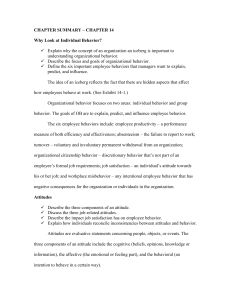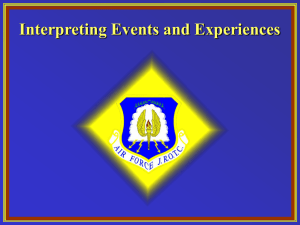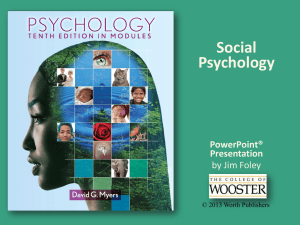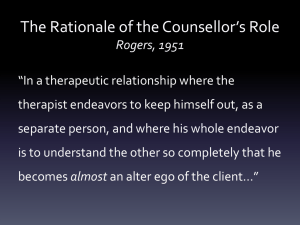Chapter 14 - cchristopherlee
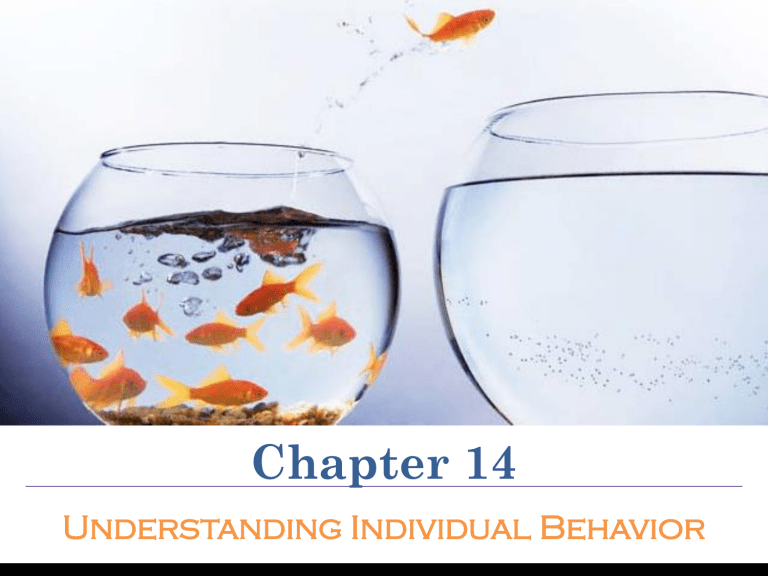
Chapter 14
Understanding Individual Behavior
Organizational Behavior (OB)
• Interdisciplinary field — study human attitudes, behavior, and performance in organizations; Important to managers as they depend on human cooperation.
• Organizational citizenship – work behavior that goes beyond job requirements and contributes to the organization’s success; the tendency of people to help one another
• Managers must select people with positive attitudes, help them contribute, and enable them to learn from workplace, to encourage organizational citizenship.
• DQ: How can a manager encourage organizational citizenship?
2
Attitudes
• Attitude = a positive or negative evaluation that predisposes a person to act in a certain way; determine:
– how people perceive the work environment, interact with others, and behave on the job
• Negative Attitude = Hard to get along with; Always gripe;
Consistently resist new ideas
• Positive Attitude = Positive, happy people are healthier, more effective, and more productive
• Managers must develop and reinforce positive attitudes
• DQ: Describe evidence of a negative attitude at workplace.
3
14.1
Components of Attitudes
(1) Cognitions
(2) Affect (feelings)
(3) Behavior
DQ: How do three components impact on an attitude?
4
High-Performance Work Attitudes
• Job Satisfaction – a positive attitude toward one’s job
• Organizational Commitment - an employee’s loyalty to and engagement with the organization
• Managers want the benefit of loyal, committed employees
Copyright ©2012 by South-Western, a division of Cengage Learning. All rights reserved. 5
14.2 Rate Your Job Satisfaction
Cognitive Dissonance
- Conflicts
Among Attitudes
• Cognitive Dissonance = a psychological discomfort that occurs when individuals recognize inconsistencies in their own attitudes and behaviors
• Cognitive Dissonance Theory = People want to behave in accordance with their attitudes and will take corrective action to alleviate the dissonance and achieve balance .
• Cognitive Dissonance & Negative Attitude: If corrective action, such as adjusting work hours, is not possible, individuals may develop negative attitudes toward their employer.
• DQ: How cognitive dissonance is related to negative attitude?
• DQ: How can a manager control employee’s cognitive dissonance?
7
Perception
..the cognitive process people use to make sense of the environment
• Perceptual Selectivity –the process of screening and selecting stimuli
• Perceptual Distortions – errors in perceptual judgment
– Stereotyping : generalizing about group or individual
– Halo effect: impression based on one characteristic
– Perceptual defense: protecting oneself against objects and ideas that are threatening
• Attributions – judgment about the cause of behavior
8
14.3 The Perception Process
Copyright ©2012 by South-Western, a division of Cengage Learning. All rights reserved.
9
Attribution
• As people organize what they perceive, they often draw conclusions about the stimuli. Attributions are judgments about what caused a person’s behavior— something about the person or something about the situation.
• An internal attribution says characteristics of the person led to the behavior.
• An external attribution says something about the situation caused the person’s behavior.
10
Attribution (continued)
Three factors influence whether an attribution will be external or internal.
1. Distinctiveness. Whether the behavior is unusual for that person.
2. Consistency. Whether the person being observed has a history of behaving in the same way.
3. Consensus. Whether other people tend to respond to similar situations in the same way.
• Fundamental attribution error is the tendency to underestimate the influence of external factors on another’s behavior and to overestimate the influence of internal factors.
• Self-serving bias is the tendency to overestimate the contribution of internal factors to one’s successes and the contribution of external factors to one’s failures.
11
14.6
Factors Influencing Whether Attributions Are Internal or External
5 Personality Traits
1. Extroversion = the degree to which a person is sociable, talkative, assertive, and comfortable with interpersonal relationships.
2. Agreeableness = the degree to which a person is able to get along with others by being good-natured, cooperative, forgiving, understanding, and trusting.
3. Conscientiousness = the degree to which a person is focused on a few goals, thus behaving in ways that are responsible, dependable, persistent, and achievement oriented.
4. Emotional stability = the degree to which a person is calm, enthusiastic, and secure, rather than tense, nervous, depressed, moody, or insecure.
5. Openness to experience = the degree to which a person has a broad range of interests and is imaginative, creative, artistically sensitive, and willing to consider new ideas.
13
14.7
The Big Five Personality Traits
Attitudes and Behaviors Influenced by Personality:
Locus of Control
• Locus of Control = Whether individuals place the primary responsibility for success or failure within themselves
(internally) or on outside forces (externally).
• People with an internal locus of control:
– Easier to motivate & better able to handle complex information
– Better at problem solving
– More achievement oriented
– More independent More difficult to manage
• People with an external locus of control:
– Harder to motivate, less involved in their jobs, and more likely to blame others,
– More compliant and conforming Easier to manage
14.8 Measuring Locus of Control
Attitudes and Behaviors Influenced by Personality:
Authoritarianism & Machiavellianism
• Authoritarianism = The belief that power and status differences should exist within the organization.
– More friction b/w a manager & employees in their degree of authoritarianism Less management effectiveness.
– The trend: The more empowerment & equitable relationships, the less authoritarianism.
• Machiavellianism = the tendency to direct much of one’s behavior toward the acquisition of power and the manipulation of others for personal gain.
– High Machs are predisposed to being pragmatic, capable of lying to achieve personal goals, more likely to win in win-lose situations, and more likely to persuade than to be persuaded.
– In loosely structured situations High Machs
– In highly structured situations Low Machs
17
Attitudes and Behaviors Influenced by Personality:
4 Problem-solving Styles
• Sensation or Intuition (Carl Jung):
– Sensation-type: facts and data
– Intuitive-type: Looking for possibilities, use abstract concepts
• Thinking or Feeling.
– Thinking-type: impersonal analysis using reason and logic
– Feeling-type: personal feelings, such as harmony, and make decisions that result in approval from others.
• 4 Problem-solving Styles:
– (1) Sensation & Thinking
– (2) Intuition & Thinking
– (3) Sensation & Feeling
– (4) Intuition & Feeling
14.9 Four Problem-Solving Styles
Attitudes and Behaviors Influenced by Personality:
Additional Sets of Personality
• Introversion vs. Extroversion
•
• Judging vs. Perceiving
• The Myers-Briggs Type Indicator (MBTI) = a personality test that measures a person’s preference for introversion vs. extroversion, sensation vs. intuition, thinking vs. feeling, and judging vs. perceiving.
– 16 personality types
– Thinking, Judging Most significant factors on Mgmt
Effectiveness
20
Person-Job Fit
• Person job fit
– Manager’s Responsibility – A manager must match the right employees with the right jobs
– Increases job satisfaction and commitment
– If this fit is poor, a manager must restructure tasks or replace employees
• Person-environment fit - employees who fit organizational environment
Emotions
• A mental state that arises spontaneously within a person based on interactions
• People cannot be separated from their emotions
• Managers can influence positive or negative emotions at work
– Emotional contagion
• Good managers pay attention to people’s emotions
22
14.10
Positive and Negative Emotions
Emotional Intelligence (EQ)
• Self-awareness = being aware of what you are feeling
• Self-management = the ability to control disruptive or harmful emotions and balance one’s moods so that worry, anxiety, fear, or anger do not cloud thinking
• Social awareness = the ability to understand others and practice empathy, putting yourself in someone else’s shoes, recognizing the feelings of others without being told
• Relationship awareness = the ability to connect to others, build positive relationships, respond to the emotions of others, and influence others
EQ (continued)
• Positive relationship between job performance and high degrees of EQ
• At times of great change or crisis, managers rely on a high EQ level to help employees cope with anxiety and stress.
•
• Managers with low EQ Undermine employee morale and harm the organization
– Make such low EQ manager improve their selfawareness
25
The Learning Process
Learning is a change in behavior or performance that occurs as the result of experience
– Ability to adapt to changes in the world
– Managers have to learn
– Active experimentation promotes learning
– Requires reflection
Managers are required to change and therefore they must learn
Copyright ©2012 by South-Western, a division of Cengage Learning. All rights reserved. 26
14.11 Experiential Learning
Cycle
Copyright ©2012 by South-Western, a division of Cengage Learning. All rights reserved.
27
Learning Styles
Individuals’ learning styles vary
Questionnaires can aid in determining learning styles
It helps for managers to know their dominant learning style
Diverger, Assimilator, Converger, and
Accommodator
.
28
14.12 What’s Your Learning Style?
Stress and Stress Management
• Work-related stress is increasing worldwide
• Low levels of stress can be a positive force
• Too much stress can have negative consequences
• Causes of Work Stress
– Task demands – role ambiguity
– Interpersonal demand – role conflict
30
Type A and Type B Behavior
Type A Behavior
Pattern characterized by extreme competitiveness, impatience, aggressiveness, and devotion to work
Copyright ©2012 by South-Western, a division of Cengage Learning. All rights reserved.
Type B Behavior
Pattern that lacks Type A characteristics and includes more balanced, relaxed lifestyle
31
Innovative Responses to
Stress Management
Quiet rooms
Wellness programs
Training programs
Manager intervention
Work-life balance initiatives
14.13 How Managers Create Stress for Employees
•
Discussion Questions (in progress)
• Define attitudes and explain their relationship to personality, perception, and behavior.
• Discuss the importance of work-related attitudes.
• Define major personality traits and describe how personality can influence workplace attitudes and behaviors.
• Identify positive and negative emotions and describe how emotions affect behavior.
• Define the four components of emotional intelligence and explain why they are important for today’s managers.
• Explain how people learn in general and in terms of individual learning styles.
• Discuss the effects of stress and identify ways individuals and organizations
• can manage stress to improve employee health, satisfaction, and productivity.
34
